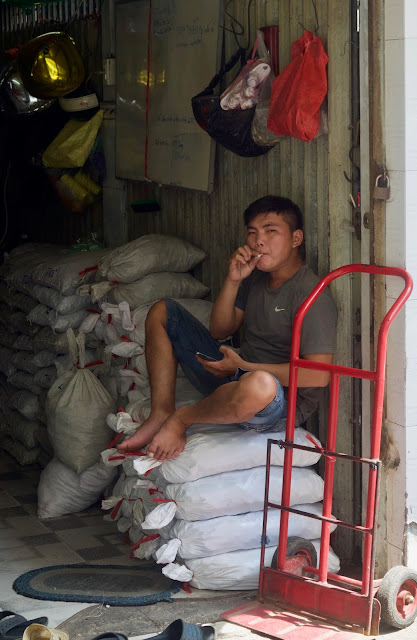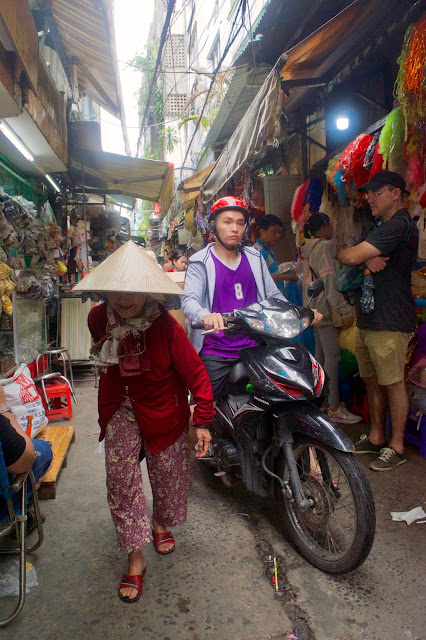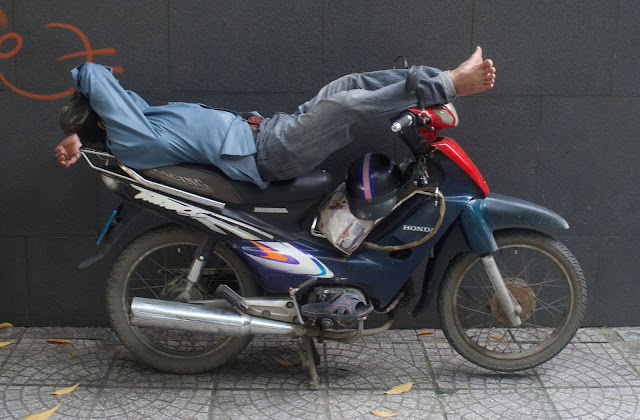 |
| A proud young father and his sleeping child. |
Thailand's northeast region, known as Isan (ee-sahn) is the largest geographical part of Thailand, and contains the largest population. Mainly agricultural, the region has several medium to large cities, which are typically provincial capitals. The cities hum with commerce, but also retain much of the traditions from its rich and varied history.
Near the northern border with Laos is the province of Udon Thani (Thailand has 77 provinces). Its capital, also called Udon Thani, has a population of about 155,000. East of the city is one of the world's earliest bronze age archaeological sites, Ban Chiang.
In this blog entry, I share photos of some of the people I encountered in this city during a recent four day excursion. It is also a departure from my normal posting of my experiences in color. All of the photos in this post are rendered in black and white, as the colorful backdrops of Udon Thani tended to distract from the images of the people. I hope you enjoy the images of the people of Udon Thani. I welcome your feedback!
All images are copyright © by the author. It is illegal for any image to be used for any purpose without permission. If interested in securing any of the images for personal or commercial use, please contact me at stilesphoto@yahoo.com.
 |
| Decorations were being placed at a Chinese temple pavilion prior to a festival. |
 |
| A traditional yoke with baskets being carried by a vendor |
 |
| I did a double take when I saw this woman pedicab driver, which is unusual enough, but her clothing and wig were eye catching. |
 |
| Her pedicab was decorated with ribbons and flags. |
 |
| Near the bustling market across from the main bus station, I waved to this child, who gave me a cute smile. |
 |
| Tired vendors |
 |
| This man seemed to be right from Lord of the Rings. |
 |
| These young women were part of a festival stage show at the night market. |
 |
| We ate at this street-side noodle stand, and when I asked if I could take their photo, these smiles were the result. |
 |
| Many small family run shops in Thailand are multi-purpose: the goods are displayed on the sidewalk, and the living space is just inside. Here a woman watches the shop while a TV show plays in the background. |
 |
| About an hour's drive east of the city is a unique temple ("wat") in the shape of a lotus bud. It is a big tourist attraction. Here, touring monks take photos to record this part of their trip. |
 |
| Novice monks ("naen") take photos of a senior monk. |
 |
| In the late afternoon shadows, these men run a small restaurant. |
 |
| This sweet woman was living on the street under an umbrella. She had her "babies" with her, and was happy to show them to me. I asked if she had no house, and she replied that she did, but it was in another province. I don't know why she was living on the street in Udon Thani, but she seemed to be pretty happy. |
 |
| These servers apparently are well known for their flamboyant clothing and wigs. They make mainly one dish: spicy papaya salad (somtam). |




























































































